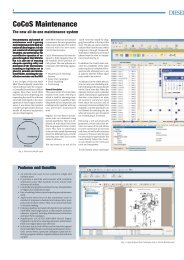LNG Carrier Propulsion by ME-GI Engines and/or Reliquefaction
LNG Carrier Propulsion by ME-GI Engines and/or Reliquefaction
LNG Carrier Propulsion by ME-GI Engines and/or Reliquefaction
Create successful ePaper yourself
Turn your PDF publications into a flip-book with our unique Google optimized e-Paper software.
To drain<br />
Hydraulic<br />
piston<br />
ELFI<br />
Prop<strong>or</strong>tional<br />
valve<br />
Suction valve<br />
High pressure pipe<br />
to the Hydraulic Cylinder Units of which<br />
there is one per cylinder, mounted on a<br />
common base plate on the top gallery<br />
level on the engine. In this figure, also<br />
the imp<strong>or</strong>tant electronic control valves,<br />
i.e. the ELFI (a prop<strong>or</strong>tional ELectronic<br />
Fuel Injection control valve) <strong>and</strong> the ELVA<br />
(an on-off ELectronic exhaust Valve<br />
Actuat<strong>or</strong>) are shown on most <strong>ME</strong>-engines<br />
will be contined.<br />
The Hydraulic Cylinder Unit furtherm<strong>or</strong>e<br />
comprises a hydraulic oil distribution block<br />
with pressure accumulat<strong>or</strong>s, the exhaust<br />
valve actuat<strong>or</strong> with ELVA, <strong>and</strong> a fuel oil<br />
pressure booster with ELFI, raising the<br />
fuel oil supply pressure during injection<br />
from the 8-bar supply pressure to the<br />
specified load-dependent injection pressure<br />
of 600-1000 bar. Permanent high<br />
pressure with preheated fuel oil on top<br />
of the engine is there<strong>by</strong> avoided, without<br />
losing any advantage of high-pressure<br />
injection.<br />
Fig. 8 shows the per cylinder fuel oil injection<br />
system, <strong>and</strong> Fig. 9 shows the individual<br />
components of the fuel oil pressure<br />
booster. As will appear, the fuel oil<br />
pressure booster is mechanically much<br />
Fuel oil inlet 8<br />
bar<br />
Membrane<br />
accumulat<strong>or</strong><br />
Hydraulic<br />
push rod<br />
Exhaust<br />
valve<br />
actuat<strong>or</strong><br />
ELVA<br />
on-off<br />
valve<br />
Exhaust<br />
valve<br />
Membrane<br />
accumulat<strong>or</strong><br />
To drain High pressure<br />
hydraulic oil – inlet<br />
Fig. 9: Fuel oil pressure booster <strong>and</strong> control valve Fig. 10: Exhaust valve actuat<strong>or</strong> <strong>and</strong><br />
control valve<br />
simpler than the traditional fuel pump<br />
with roller, roller guide, VIT <strong>and</strong> cut-off<br />
wedges.<br />
About 15,000 hours have been logged<br />
on the first <strong>ME</strong> engine in service, <strong>and</strong><br />
there has been virtually nothing to rep<strong>or</strong>t.<br />
The fuel oil pressure booster is less exposed<br />
to wear than a traditional fuel oil<br />
Starting air<br />
distribut<strong>or</strong><br />
High pressure<br />
hydraulic oil – inlet<br />
Slide fuel<br />
valve<br />
MC design <strong>ME</strong> design<br />
Starting valves<br />
The NC valve is mounted on the main<br />
starting pipe behind the cylinder cover<br />
Fig.11: <strong>ME</strong> engine starting air system<br />
pump <strong>and</strong>, with its significantly larger<br />
sealing length compared with the conventional<br />
Bosch-type fuel pumps, a<br />
longer lifetime can be expected.<br />
Fig. 10 shows the actuat<strong>or</strong> f<strong>or</strong> the exhaust<br />
valve which responds to the electronic<br />
actuat<strong>or</strong> signal from the engine control<br />
system.<br />
Blow-off<br />
NC-valves<br />
Starting valves<br />
Pilot air inlet<br />
Connection<br />
f<strong>or</strong><br />
ECS<br />
9




